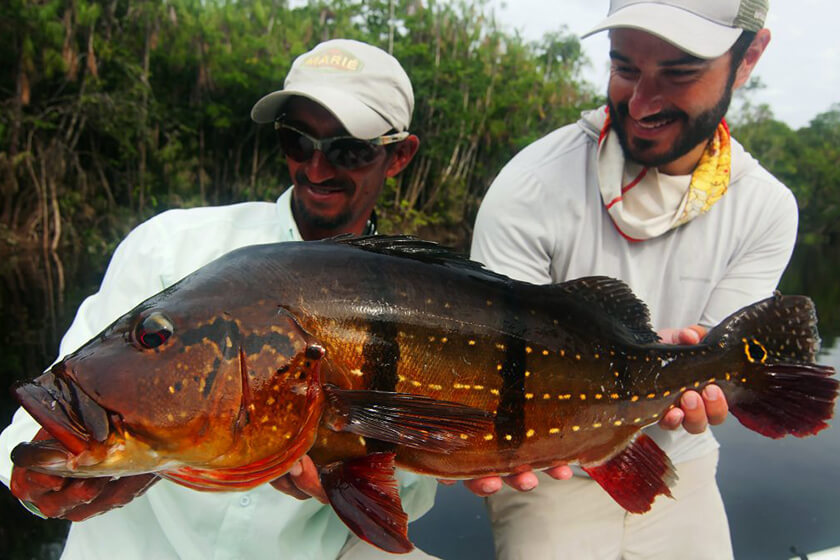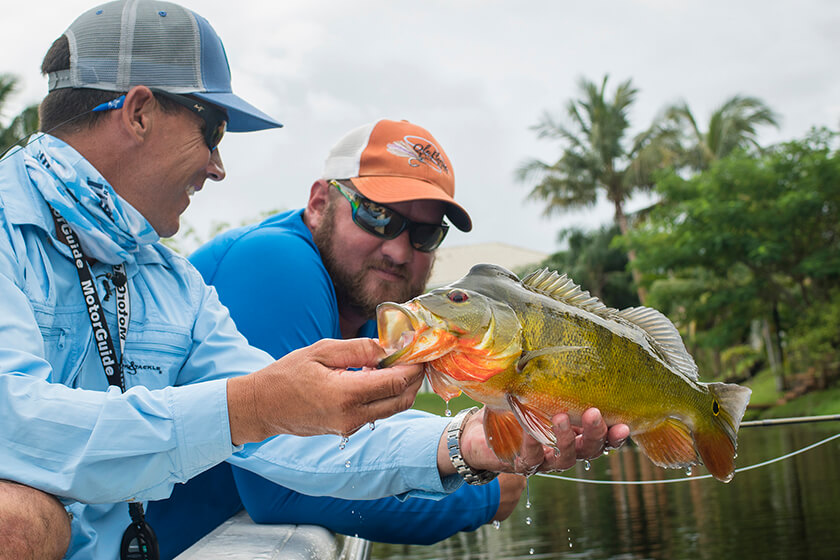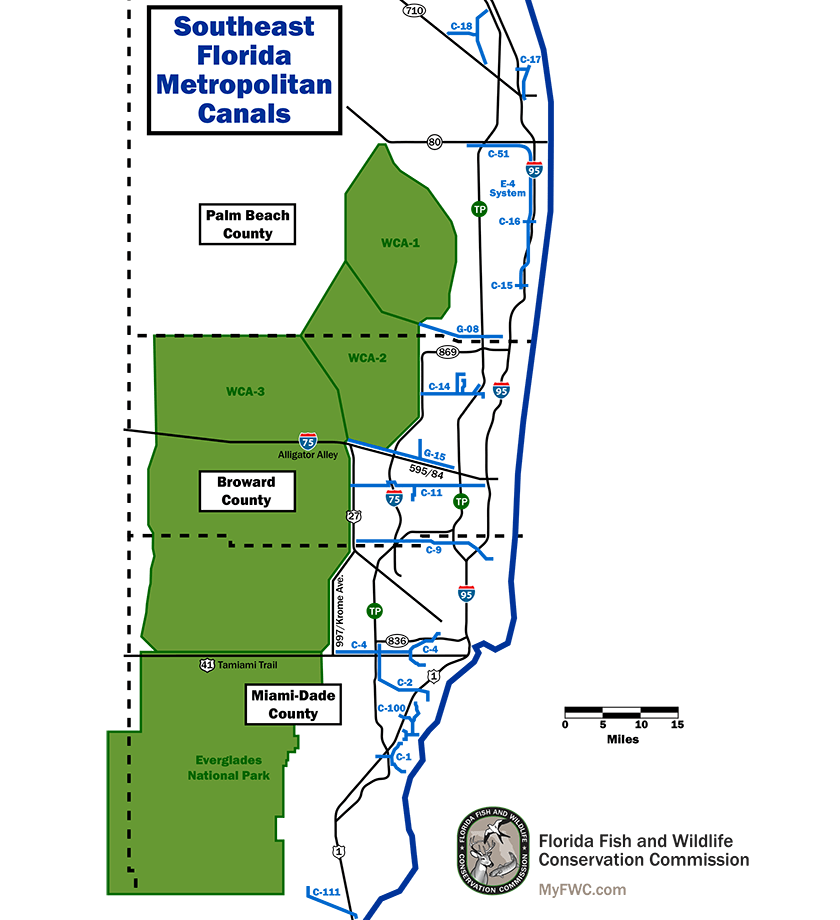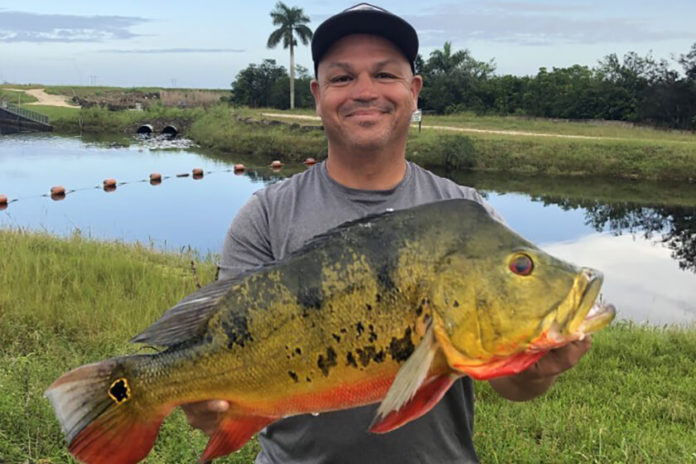Felipe Prieto, of Hialeah, Fl, holds the new state record 9.11 pounds butterfly peacock bass he caught in a southwest Broward County lake. Photo courtesy of FWC
October 12, 2021
For yours truly, the butterfly peacock bass in southern Florida has been a two or three-pound specimen caught after an ICAST convention trip, all to make a bucket list memory and to check off another box on the career fly rod list.
But for Hialeah, Fla. angler Felipe Prieto, the peacock bass is the afterwork fish of a lifetime, one that he’ll never forget after a recent post-work outing that produced a new state record peacock weighing 9.11-pounds and measuring 23 5/16-inches in length.
Using a live shiner in an unnamed Broward County water body, Preito fished the lake with a live shiner on the edge of a deep ledge. When the fish struck and he reeled it in, the angler was left almost speechless according to an Instagram post by Game and Fish Magazine’sOutdoor Sportsman Group sister publication, Florida Sportsman.
“It was an amazing catch and battle that still has me in shock,” Prieto said in the IG post. “Incredible.”

Indeed, it was, breaking a longstanding Sunshine State record for the exotic species that swims in freshwater lakes, ponds, and canals along and near the state’s southeastern coastline. In fact, according to the Florida Fish and Wildlife Conservation Commission, Prieto’s recent catch breaks the previous peacock benchmark of 9.08 pounds set nearly three decades ago.
That fish, a 9.08-pound peacock pulled from Dade County’s Kendall Lakes on March 11, 1993, according to the Florida Big Catch state record page, was caught by angler Jerry Gomez, who was also using a spinning rod for his former record catch.
While both of those record catches are certainly remarkable, the FWC notes on its Big Catch page that even larger peacock bass have been documented by biologists over the years, but not all of the state record reporting requirements were met, so the fish couldn’t be certified.
While many anglers think of Brazil—and a few other locations in South America where the native range of the butterfly peacock bass is found—they are typically smaller than the giant peacocks known as Cichla temensis, a powerful Amazonian predator that can reach weights upward of 20 pounds or more.

A beautiful predator that lures anglers from all over the world like Ross Purnell, editor of Game and Fish’s sister publication Fly Fisherman magazine and frequent Fly Fisherman contributor and Simms Fishing Products guru John G. Sherman , the simple truth is that you don’t need a passport to seek hard fighting peacocks as Prieto’s recent catch certainly proves.
In fact, the fish are plentiful near the Miami area, first stocked by FWC biologists in Florida’s southeastern coastal canals back in 1984 in an effort to help reduce the number of undesirable exotic fish species that were making themselves home in that portion of the state.
How big a problem are the unwanted exotics in southeastern Florida? Plenty big, in fact, since a story by Fly Fisherman writer Walt Jennings noted a few years ago that over the last century, at least 86 undesirable exotic fish species have found their way into southeastern Florida waters after post-hurricane flooding, illegal aquarium dumps from homes, etc.
Since some of those exotics—especially species like the spotted tilapia and Oscars—reproduce prolifically and harm native species like bluegills and largemouth bass, the peacocks are an unusual exotic fish that bring about a desirable outcome of fish control and sport angling possibilities.
While the butterfly peacocks don’t fare well in rare cold weather events pushing onto the Florida peninsula—the same kind of weather that hurts the Sunshine State’s native snook population—recent mild winters have allowed the peacocks to expand as far north as Palm Beach County. Given the peacock’s Amazonian roots, that appears to be the species northern boundary in Florida for now.

Those same mild winters, not to mention an abundant forage base of other exotic fish and native baitfish, have also enabled Florida’s peacocks to reach some sizable dimensions once again.
“The butterfly peacock bass is colorful, a lightning-fast striker and a hard fighter,” said FWC Commission Chairman Rodney Barreto, in a FWC news release. “Anglers from across the country travel here to catch a peacock bass, which only adds to the tremendous economic impact fishing has in Florida. This unique game fish is just one of the features that makes Florida, truly, the Fishing and Boating Capital of the World.”
Interested in catching a butterfly peacock bass in the Sunshine State? If so, there are two ways that anglers can go about seeking out a bucket list catch in the Lower 48.
First, you can hire a guide that specializes in targeting the species, someone like Capt. Patrick Smith of Swamp to Sea Guide Service in the Palm Beach area. Guides like Smith usually provide gear like fly rods, spinning rods, small baitfish like live shad or shiners, baitfish imitating flies and lures, and small skiffs or bass rigs to fish from. Better yet, they’ll provide knowledge and expertise of where to look for peacocks in the extensive lakes and canal systems near and north of the greater Miami metropolitan area.

Second, you can opt to fish for peacocks on your own, armed with a do-it-yourself attitude, the proper licensing, and some light fishing tackle.
If fly fishing is your game, a five-, six-, or seven-weight fly rod will suffice, along with a weight-forward floating line, a 7 ½- or 9-foot leader, and a selection of baitfish imitating flies like Clouser minnows, Lefty’s Deceivers, Gummi Minnows, or small Game Changers. If you like conventional tackle, a medium sized spinning rod-and-reel combo, some monofilament or fluorocarbon line in the 6- to 10-pound test range, small lures like shallow running crankbaits or jerkbaits, or live bait options from area bait shops will all suffice.

After the necessary gear and licensing, the only other thing that you’ll need is a vehicle and maps to the extensive canal system found throughout southeastern Florida, which totals more than 300 miles worth of water in Dade and Broward counties.
Fortunately, the FWC offers an extensive selection of online maps and fishing suggestions for butterfly peacocks no matter what part of the Miami to Palm Beach area you’re fishing in.
And if you happen to set the hook into a Florida peacock bass weighing nine-pounds or better, the only other thing to note is what to do if you catch a fish that might exceed the state’s newest benchmark.

According to the FWC, to properly certify a new freshwater Florida state record, an angler should note that an FWC biologist must identify the species and an FWC employee must witness its weighing on a certified scale. If an angler thinks they have caught a potential record fish, they are encouraged to notify the nearest FWC regional office.
Also don’t forget to take a photograph of the fish on a scale with the weight being visible.
Even if the butterfly peacock—or another freshwater fish—isn’t state record caliber, FWC notes that it also recognizes other memorable catches through the agency’s Big Catch Program. And if the fish is a largemouth bass, FWC recognizes the catch, documentation, and release of bucketmouths through its citizen science angling program known as Trophy Catch.
The bottom line is that if your travel plans this year or next take you to the greater Miami area, it only takes a few minutes worth of time and some simple gear to catch the bucket list fish of a lifetime, a sizable and beautiful peacock bass that you’ll remember forever.
And all without having to remember your passport, get on an airplane, and fly to South America, no less.
Credit: Source link






























